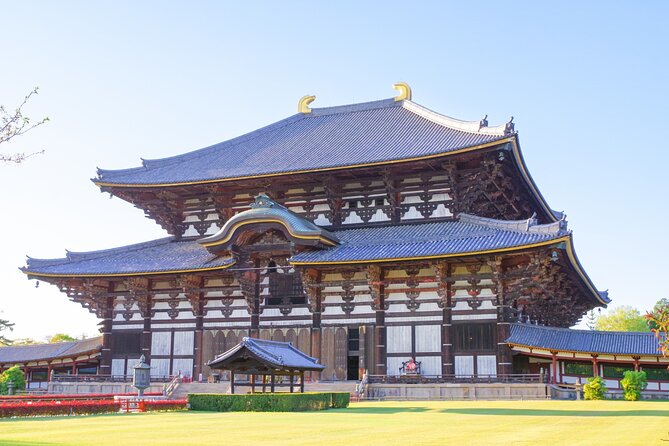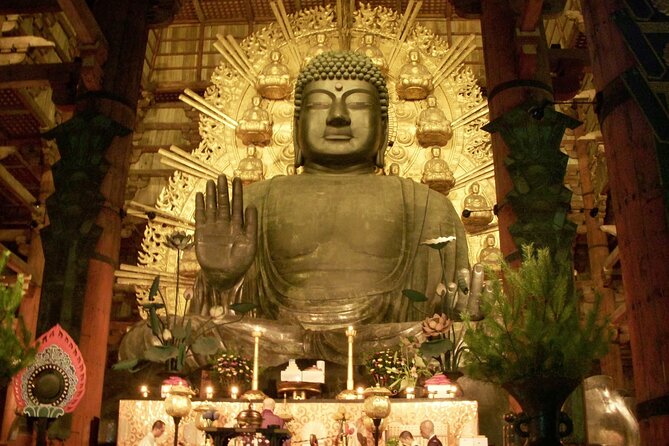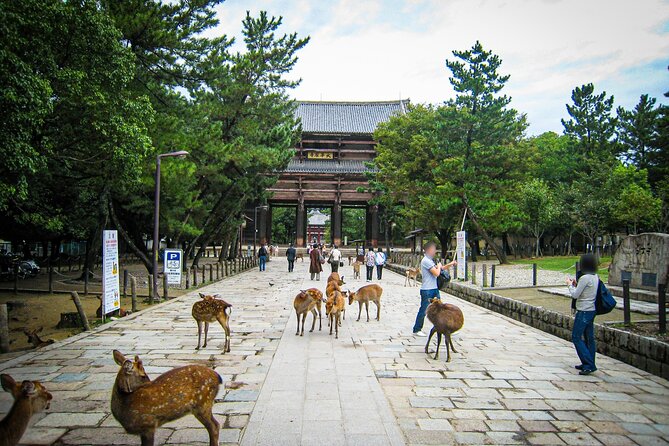As the morning sun gently rises over the ancient city of Nara, a sense of tranquility blankets the streets, awakening a spirit of exploration in all who visit.
Like a thread weaving through the tapestry of time, the Nara World Heritage Todaiji Visit and Naramachi Tour invites travelers to embark on a journey of culture and discovery.
Picture yourself standing in awe before the majestic Todaiji Temple, its towering presence mirroring the grandeur of Japan’s rich historical legacy.
But this is just the beginning. As you wander through the narrow lanes of Naramachi, a neighborhood frozen in time, you’ll find yourself yearning to uncover the secrets hidden within its traditional merchant houses and cobblestone paths.
With every step, you’ll uncover a new layer of Nara’s captivating heritage, leaving you eager to unravel what lies ahead.
Good To Know

- Todaiji Temple is a World Heritage Site and houses the largest bronze statue of Buddha in Japan.
- Nara Park is located in the heart of the city and is home to over 1,200 wild deer.
- Naramachi is a historic district of Nara that preserves the atmosphere of traditional Japan.
- Nara has a rich history and heritage, being the former capital of Japan and home to iconic landmarks such as Todaiji Temple and preserved traditional houses in Naramachi.
Todaiji Temple: A World Heritage Site

Todaiji Temple, designated as a World Heritage Site, stands as a magnificent testament to the rich history and cultural significance of Nara, Japan. This iconic temple, located in Nara Park, is renowned for its immense size and stunning architecture.
As one of Japan’s most important Buddhist temples, Todaiji holds immense spiritual and historical significance. Built in the 8th century, it was originally constructed to promote Buddhism and serve as the head temple of the influential Kegon sect. The main hall, known as the Daibutsuden, houses the Great Buddha statue, which is the largest bronze statue of Buddha in Japan.
The temple’s architecture showcases a seamless fusion of traditional Japanese and Chinese influences, making it a captivating sight for visitors from around the world. The grandeur and cultural importance of Todaiji Temple make it a must-visit destination for anyone exploring Nara.
https://www.viator.com/tours/Nara/Nara-World-Heritage-Todaiji-Visit-and-Naramachi-Tour/d50510-416969P3
Exploring Naramachi: A Traditional Neighborhood

Naramachi, a traditional neighborhood in Nara, Japan, offers a captivating glimpse into the rich history and culture of the region. As visitors stroll through the narrow streets lined with well-preserved machiya houses, they can enjoy the atmosphere of old Japan.
Naramachi is known for its traditional crafts, and visitors can explore shops selling handmade pottery, textiles, and lacquerware. The neighborhood is also a culinary delight, with numerous local eateries serving up delicious Nara cuisine. From savory soy-based dishes to sweet treats made with local ingredients, there’s something for every palate.
Exploring Naramachi is like stepping back in time, where the past meets the present, and visitors can experience the authentic charm of this traditional neighborhood while indulging in its traditional crafts and local cuisine.
Discovering the Rich History of Nara
With its roots dating back over a thousand years, Nara boasts a rich history that beckons visitors to uncover its hidden stories and enjoy its ancient wonders.
Nara’s historical significance can’t be overstated, as it was once the capital of Japan and played a crucial role in shaping the country’s culture and heritage.
Exploring Nara’s ancient architecture is like stepping back in time, with iconic landmarks such as the Todaiji Temple and its awe-inspiring Great Buddha Hall. This wooden structure is the largest of its kind in the world and stands as a testament to the craftsmanship and ingenuity of the ancient Japanese people.
As visitors wander through the streets of Naramachi, they’ll encounter beautifully preserved traditional houses and gain a deeper understanding of the everyday life in ancient Nara.
From majestic temples to quaint neighborhoods, Nara’s rich history is waiting to be discovered.
Nara Park: Home to Sacred Deer and Beautiful Scenery

As visitors continue their journey through Nara’s captivating history, they’ll be drawn to Nara Park, a picturesque oasis that’s home to sacred deer and boasts breathtaking scenery. Here, they can enjoy the natural beauty and cultural significance of this renowned park.
Here are four reasons why Nara Park is a must-visit destination:
-
Feeding Deer: One of the main attractions of Nara Park is the opportunity to feed the friendly and sacred deer that roam freely within its boundaries. Visitors can purchase special deer crackers and interact with these gentle creatures, creating unforgettable memories.
-
Parks and Gardens: Nara Park isn’t only home to deer but also features expansive green spaces and beautifully manicured gardens. It provides a tranquil escape from the bustling city and offers visitors a chance to relax, picnic, or simply enjoy a leisurely stroll amidst nature’s splendor.
-
Temples: Within Nara Park, visitors will find several significant temples that showcase the rich cultural heritage of Japan. The most famous is the Todai-ji Temple, which houses the Great Buddha, a monumental bronze statue that’s a marvel to behold.
-
Japanese Culture: Nara Park provides a unique opportunity to take in Japanese culture. From witnessing traditional rituals at the temples to observing locals engaging with the deer, visitors can gain insights into the customs and traditions that are deeply rooted in this historical city.
Nara Park is a captivating destination that combines natural beauty, cultural significance, and the chance to interact with sacred deer. It’s a place where visitors can experience the essence of Japanese culture while being surrounded by stunning scenery.
Must-See Sights in Nara: Todaiji and Naramachi

Todaiji and Naramachi are two must-see sights in Nara that offer a captivating glimpse into the rich history and cultural heritage of this ancient city.
Todaiji, a UNESCO World Heritage site, is home to the Great Buddha, a towering statue that’s a marvel to behold. Visitors can explore the vast temple complex and marvel at the intricate architecture and beautiful gardens.
Naramachi, on the other hand, is a historic district filled with traditional machiya houses and narrow streets. It’s the perfect place to take in the local culture and experience the charm of old Nara.
While exploring these sights, visitors can also indulge in the local cuisine in Nara, which includes delicacies such as kakinoha-zushi (sushi wrapped in persimmon leaves) and sake.
Nara truly offers a unique and unforgettable experience for those seeking to discover Japan’s cultural treasures.
Immerse Yourself in Nara’s Cultural Treasures

Enjoy the cultural treasures of Nara as you explore the enchanting historic district of Naramachi and witness the awe-inspiring beauty of Todaiji, a UNESCO World Heritage site.
Here are four reasons why Nara’s cultural heritage and traditional neighborhoods are a must-see:
-
Naramachi: Step back in time as you wander through the narrow streets of Naramachi. Here, you’ll find well-preserved traditional buildings that offer a glimpse into the daily life of the locals in the past.
-
Traditional Crafts: Nara is known for its exquisite traditional crafts, such as lacquerware, ceramics, and textiles. Take the opportunity to visit workshops and galleries to witness the skill and craftsmanship behind these timeless creations.
-
Temples and Shrines: Nara is home to numerous temples and shrines, each with its own unique history and architectural style. Explore the serene grounds, admire the intricate details, and experience the spiritual atmosphere that permeates these sacred sites.
-
Cultural Festivals: Throughout the year, Nara hosts vibrant cultural festivals that showcase its rich heritage. From the lively processions of the Omizutori Festival to the graceful dances of the Nara Tokae Festival, these events provide a deeper insight into the traditions and beliefs of the local community.
Enjoy Nara’s cultural treasures and let the spirit of the past guide your journey through this captivating city.
Frequently Asked Questions

How Long Is the Nara World Heritage Todaiji Visit and Naramachi Tour?
The duration of the Nara World Heritage Todaiji Visit and Naramachi Tour varies depending on the group size and pace. It is child-friendly and includes transportation. Meals are not included. The experience duration is engaging and informative.
Can Children Participate in the Tour?
Yes, children can participate in the tour. There are no age restrictions for children’s activities, allowing families to enjoy the Nara World Heritage Todaiji visit and Naramachi tour together.
Is Transportation Provided to and From the Tour Locations?
Transportation details and travel arrangements are provided for the Nara World Heritage Todaiji Visit and Naramachi Tour. Participants can expect convenient transportation to and from the tour locations, ensuring a hassle-free experience.
Are Food and Drinks Included in the Tour Price?
Food and drinks are included in the tour price. Visitors with dietary restrictions can enjoy a variety of options. The tour provides a chance to savor local cuisine and beverages, enhancing the overall experience.
What Is the Maximum Number of Travelers Allowed on the Tour?
The maximum capacity for the tour is subject to group size limitations. The tour operator ensures a comfortable and enjoyable experience by maintaining an appropriate number of travelers.
The Sum Up

To sum it up, the Nara World Heritage Todaiji Visit and Naramachi Tour offers an immersive and captivating journey into the heart of Japan’s rich cultural heritage.
Despite its popularity, some may argue that the tour is too touristy. However, by exploring the lesser-known streets of Naramachi and delving into the history and spirituality of Todaiji Temple, you will discover a deeper connection to Japan’s traditions and gain a truly authentic experience.
Don’t miss the opportunity to be transported back in time and embrace the cultural treasures of Nara.






